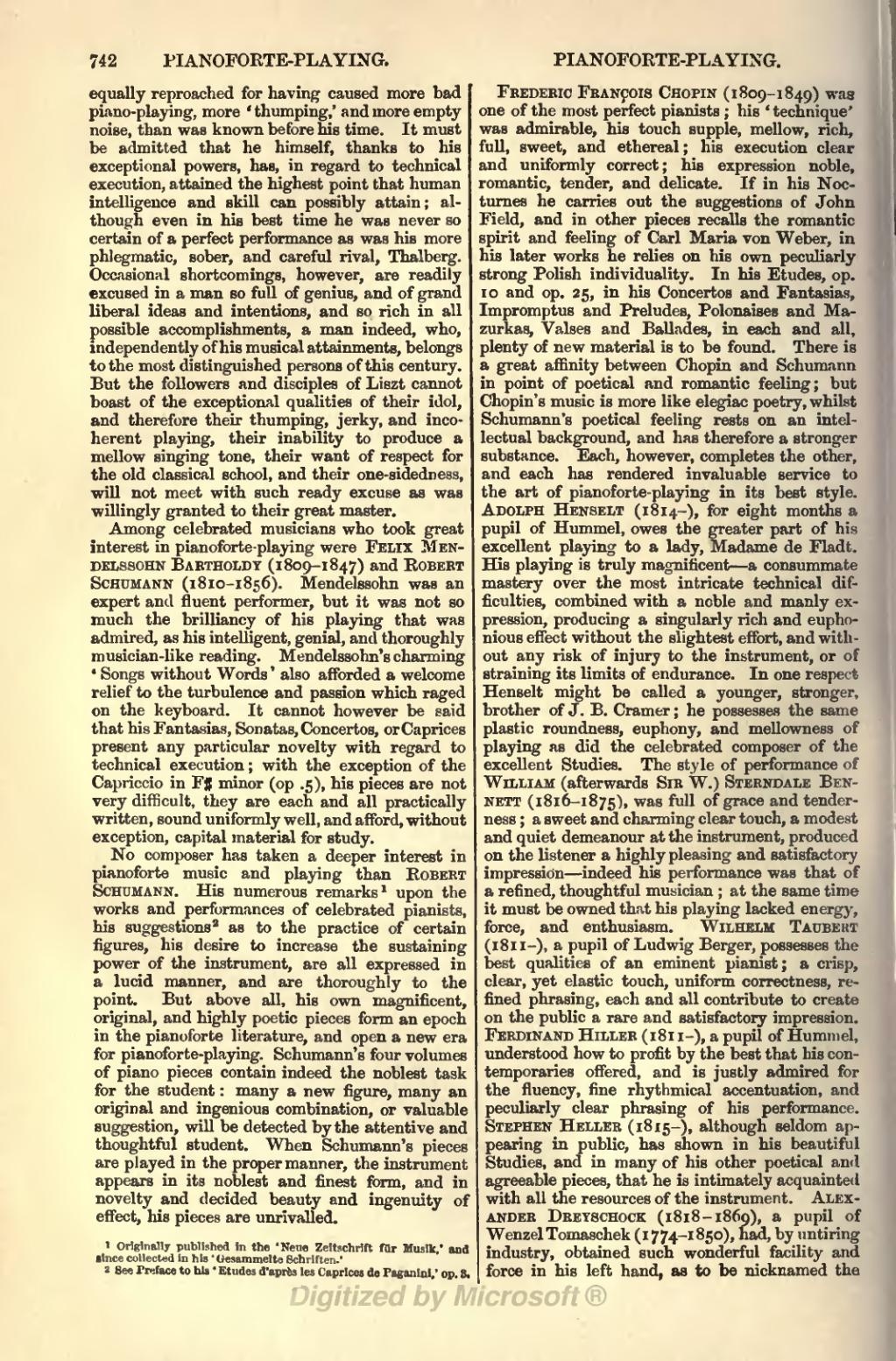equally reproached for having caused more bad piano-playing, more 'thumping,' and more empty noise, than was known before his time. It must be admitted that he himself, thanks to his exceptional powers, has, in regard to technical execution, attained the highest point that human intelligence and skill can possibly attain; although even in his best time he was never so certain of a perfect performance as was his more phlegmatic, sober, and careful rival, Thalberg. Occasional shortcomings, however, are readily excused in a man so full of genius, and of grand liberal ideas and intentions, and so rich in all possible accomplishments, a man indeed, who, independently of his musical attainments, belongs to the most distinguished persons of this century. But the followers and disciples of Liszt cannot boast of the exceptional qualities of their idol, and therefore their thumping, jerky, and incoherent playing, their inability to produce a mellow singing tone, their want of respect for the old classical school, and their one-sidedness, will not meet with such ready excuse as was willingly granted to their great master.
Among celebrated musicians who took great interest in pianoforte-playing were Felix Mendelssohn Bartholdy (1809–1847) and Robert Schumann (1810–1856). Mendelssohn was an expert and fluent performer, but it was not so much the brilliancy of his playing that was admired, as his intelligent, genial, and thoroughly musician-like reading. Mendelssohn's charming 'Songs without Words' also afforded a welcome relief to the turbulence and passion which raged on the keyboard. It cannot however be said that his Fantasias, Sonatas, Concertos, or Caprices present any particular novelty with regard to technical execution; with the exception of the Capriccio in F♯ minor (op. 5), his pieces are not very difficult, they are each and all practically written, sound uniformly well, and afford, without exception, capital material for study.
No composer has taken a deeper interest in pianoforte music and playing than Robert Schumann. His numerous remarks[1] upon the works and performances of celebrated pianists, his suggestions[2] as to the practice of certain figures, his desire to increase the sustaining power of the instrument, are all expressed in a lucid manner, and are thoroughly to the point. But above all, his own magnificent, original, and highly poetic pieces form an epoch in the pianoforte literature, and open a new era for pianoforte-playing. Schumann's four volumes of piano pieces contain indeed the noblest task for the student: many a new figure, many an original and ingenious combination, or valuable suggestion, will be detected by the attentive and thoughtful student. When Schumann's pieces are played in the proper manner, the instrument appears in its noblest and finest form, and in novelty and decided beauty and ingenuity of effect, his pieces are unrivalled.
Frederic François Chopin (1809–1849) was one of the most perfect pianists; his 'technique' was admirable, his touch supple, mellow, rich, full, sweet, and ethereal; his execution clear and uniformly correct; his expression noble, romantic, tender, and delicate. If in his Nocturnes he carries out the suggestions of John Field, and in other pieces recalls the romantic spirit and feeling of Carl Maria von Weber, in his later works he relies on his own peculiarly strong Polish individuality. In his Etudes, op. 10 and op. 25, in his Concertos and Fantasias, Impromptus and Preludes, Polonaises and Mazurkas, Valses and Ballades, in each and all, plenty of new material is to be found. There is a great affinity between Chopin and Schumann in point of poetical and romantic feeling; but Chopin's music is more like elegiac poetry, whilst Schumann's poetical feeling rests on an intellectual background, and has therefore a stronger substance. Each, however, completes the other, and each has rendered invaluable service to the art of pianoforte-playing in its best style. Adolph Henselt (1814–), for eight months a pupil of Hummel, owes the greater part of his excellent playing to a lady, Madame de Fladt. His playing is truly magnificent—a consummate mastery over the most intricate technical difficulties, combined with a noble and manly expression, producing a singularly rich and euphonious effect without the slightest effort, and without any risk of injury to the instrument, or of straining its limits of endurance. In one respect Henselt might be called a younger, stronger, brother of J. B. Cramer; he possesses the same plastic roundness, euphony, and mellowness of playing as did the celebrated composer of the excellent Studies. The style of performance of William (afterwards Sir W.) Sterndale Bennett (1816–1875), was full of grace and tenderness; a sweet and charming clear touch, a modest and quiet demeanour at the instrument, produced on the listener a highly pleasing and satisfactory impression—indeed his performance was that of a refined, thoughtful musician; at the same time it must be owned that his playing lacked energy, force, and enthusiasm. Wilhelm Taubert (1811–), a pupil of Ludwig Berger, possesses the best qualities of an eminent pianist; a crisp, clear, yet elastic touch, uniform correctness, refined phrasing, each and all contribute to create on the public a rare and satisfactory impression. Ferdinand Hiller (1811– [App. p.748 "date of death 1885"]), a pupil of Hummel, understood how to profit by the best that his contemporaries offered, and is justly admired for the fluency, fine rhythmical accentuation, and peculiarly clear phrasing of his performance. Stephen Heller (1815–), although seldom appearing in public, has shown in his beautiful Studies, and in many of his other poetical and agreeable pieces, that he is intimately acquainted with all the resources of the instrument. Alexander Dreyschock (1818–1869), a pupil of Wenzel Tomaschek (1774–1850), had, by untiring industry, obtained such wonderful facility and force in his left hand, as to be nicknamed the

